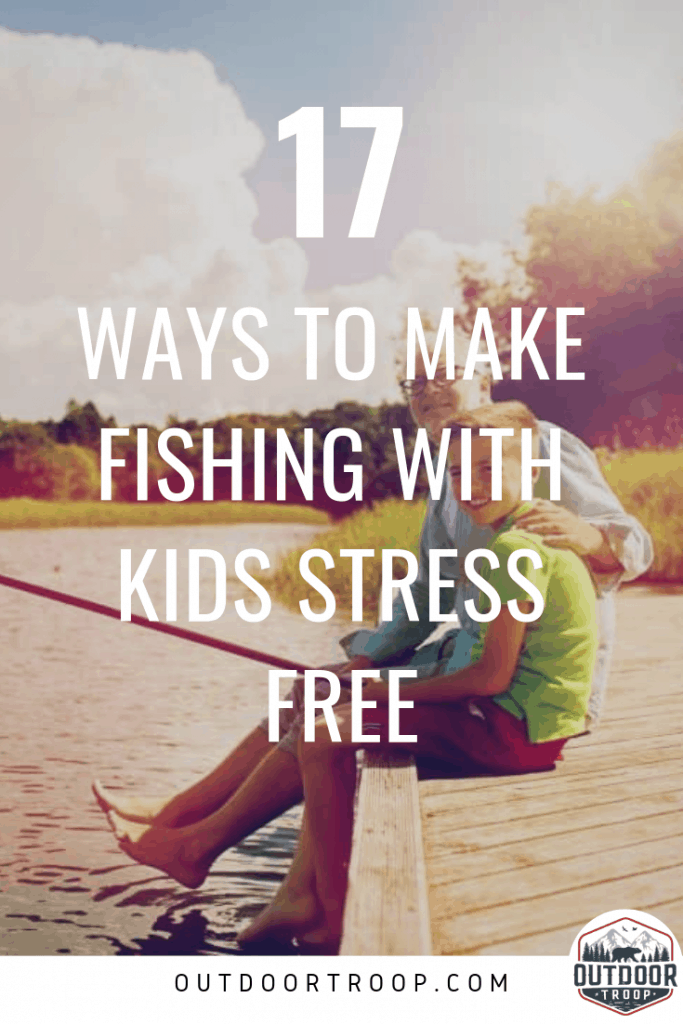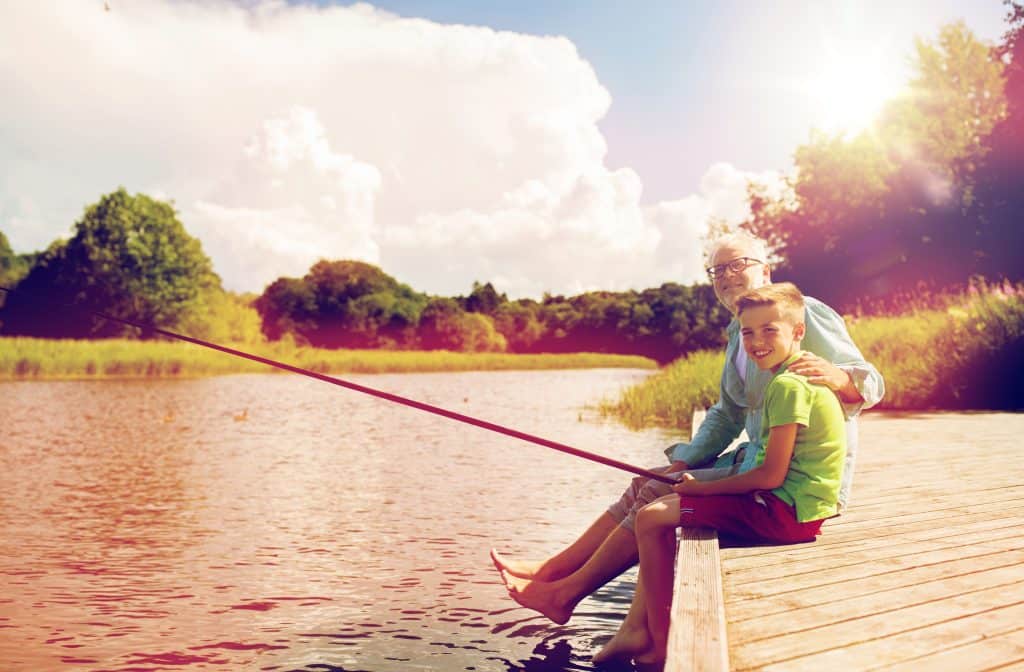
Fishing is an awesome hobby with benefits for the body and mind! It can also be a great activity to do as a family, though you may have to do things a bit differently with kids involved. Below are a few tricks to make your experience more fun and fulfilling.
Here are 17 tips for fishing with kids:
- Get Everyone Licensed
- Pick a Good Location
- Limit Your Time
- Educate Beforehand
- Buy Kid-Friendly Gear
- Emphasize Safety
- Start with Bait or Spin Lures
- Practice Casting
- Wear Flotation Devices
- Stay in Contact
- Use Braid Lines
- Use Barbless Hooks
- Bring Food and Water
- Apply Sunscreen and Bug Spray
- Protect Your Eyes
- Bring First Aid Kits
- Make it Fun!
Kids are naturally curious and fishing is a great way to get them interested in the outdoors. We’ll explore and explain each tip below.
#1: Get Everyone Licensed
Before you get started on any preparations for your family fishing trip, the first thing you’ll need to do is check the fishing license laws for your area.
Adults will always need a fishing license, which is renewed annually, but the rules vary when it comes to children.
Depending on which state you live in and the age of the kids you want to bring along, there may be reduced license fees. In addition, most locations will allow children under the age of 12 to fish for free; no license required!
If you’ve got older kids or teenagers though, licenses are a must. Do a little research for your particular state and make sure you’re following the rules to get everyone licensed.
#2: Pick a Good Location
If you’re an experienced fisherman, you probably have a few favorite places to go. However, when you’re bringing children along, you’ll need to think about the terrain a little differently.
Although young kids have a lot of energy, it’s harder for them to climb, wade, and negotiate difficult landscapes.
When you want to bring kids along, the first thing to do is to pick an easy starting location without too many obstacles. Fast moving water should be avoided, as well as shorelines that are unstable and difficult to fish from.
Even though the easier areas may be more crowded or have less fish in them, safety should be the first priority when children are concerned. As they grow older you can work up to the more advanced areas!
#3: Limit Your Time
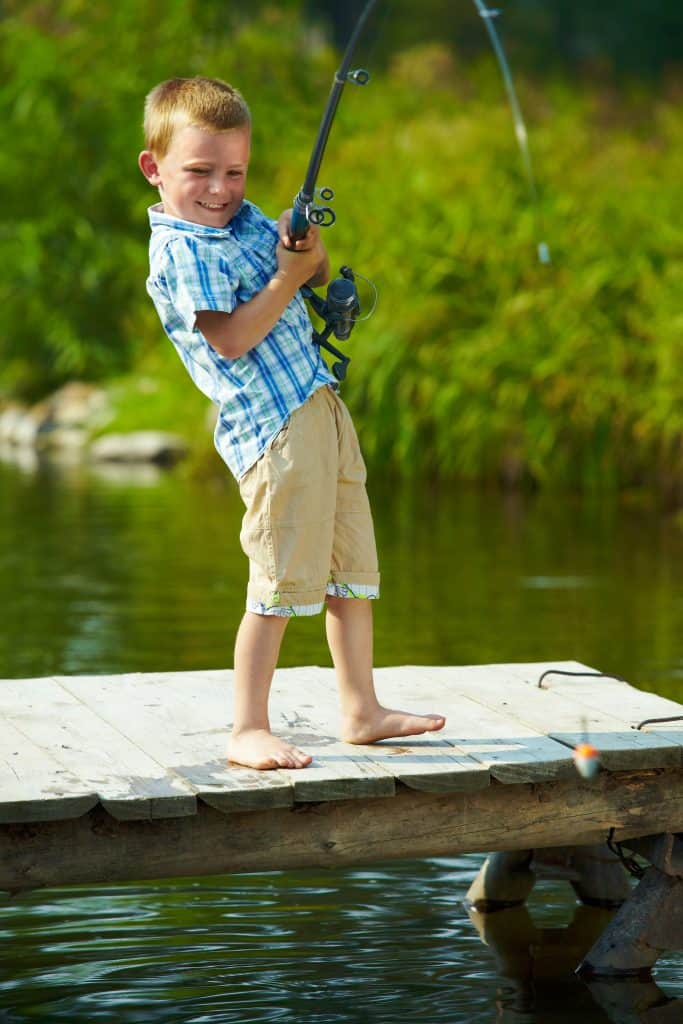
No matter how fun your fishing trip is, kids will usually get bored with it after awhile. If they’re not used to this activity, it can get boring and frustrating quickly.
To make this a better experience for everyone, plan on only spending a couple of hours on every trip. You’ll be able to spend a few meaningful hours instead of several boring ones.
Limiting your time will also prevent heat exhaustion and other complications of outdoor exposure.
If your group has particularly short attention spans, you can also vary the activities of the trip to hold their interest. If fishing starts to feel boring to them, you can take a break and explore the area, have a meal, or enjoy a separate activity.
#4: Educate Beforehand
Fishing will be much more enjoyable and engaging if you teach your group about it beforehand. Consider involving the kids with your preparations and teaching them about the fish and other wildlife you might see on the way.
There are lots of ways to educate and involve children in your fishing experience. If you’re using live bait, try recruiting your kids to catch some grasshoppers or dig up worms. This will help them participate and assist in your trip!
You can also go through books, nature films, or online quizzes to learn about the fish you’ll be targeting. Educating and involving your kids will make the trip a more immersive and memorable experience.
#5: Buy Kid-Friendly Gear
If you want your kids to have the best fishing experience possible, a large part of that is going to fall on the equipment they have. Adult sized fishing rods probably won’t do the trick. They’re usually too big and too long for young kids to handle comfortably.
If you have very small children, buying small trainer rods may be the best option. Kids will grow out of these eventually, but they’re much easier to handle and operate safely.
A variety of beginner fishing packs for kids are available at local fishing shops as well as online retailers such as Amazon. One of the most popular and highly recommended is the PLUSINNO Kid’s Fishing Pole.
This set comes with a downsized rod and reel, as well as a variety of hooks, bobbers, and weights.
For older kids and teenagers, you’re probably fine to let them use full-size gear.
#6: Emphasize Safety
Fishing is a fun activity and it’s great to get kids started early! But it still involves an element of risk. There are sharp objects, water hazards, and a variety of natural dangers to consider.
Before you let your kids loose on the river, take a minute to teach them about the potential dangers. Show them how to safely handle and store their gear, which areas to avoid, and what to do in case of an emergency.
Some things might seem obvious to you if you’ve been fishing for years, but remember that you’re working with beginners.
Teach everyone how to carry their fishing poles correctly and where to store hooks and lures.
Taking some time to teach everyone about the importance of safety will keep the kids and your gear in good shape. There will be less of a chance of something breaking or someone getting into a bad situation if you educate everyone beforehand.
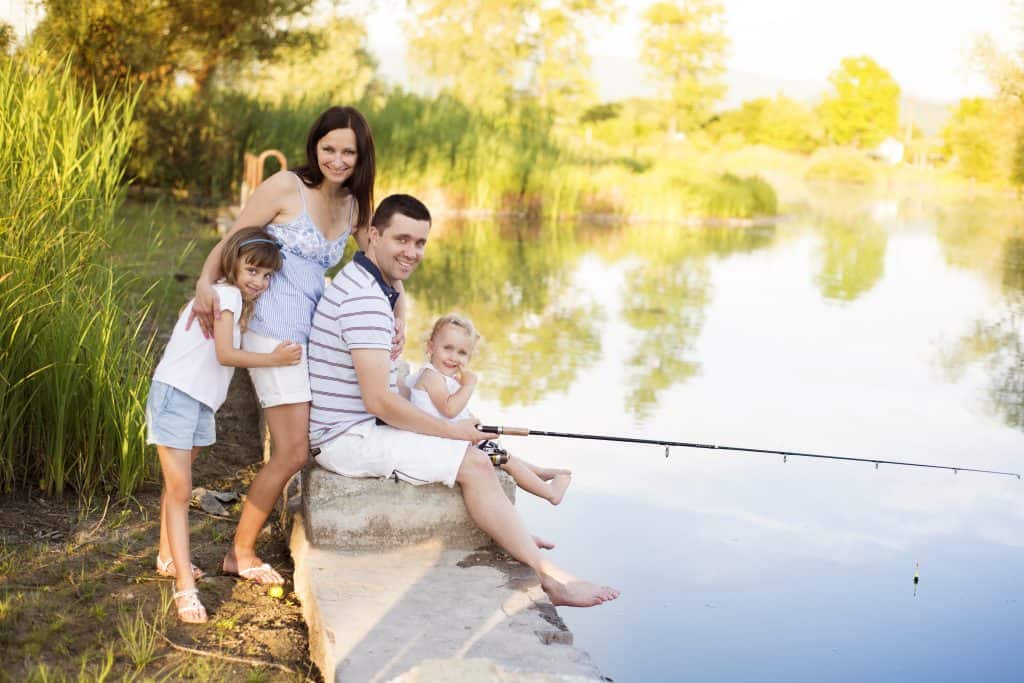
#7: Start with Bait or Spin Lures
You might be a very accomplished fly fisherman, but that’s not a great technique for a kid to start out with. Becoming skilled in fly fishing can take a lot of practice and a fine-tuned technique.
Kids can definitely learn these skills too, but starting them off with live bait or spin lures usually provides a more rewarding experience for them.
Live bait is a great way to draw the attention of fish. Show each kid how to properly bait a line. They might be squeamish at first, but it’s good for them to learn how to do it themselves!
If live bait isn’t up your alley, spin lures are also easy for fish to see and track. They also don’t need to be replaced as often as bait and are easy to store and reuse.
#8: Practice Casting
Although fishing might seem like second nature to a lot of people, it’s still a skill that takes time and practice to learn. Most kids get the general idea of casting but they might have a hard time
Take some time with each child to give them some basic tips and instruction. They don’t have to be perfect at the beginning, but getting everyone off to a good start can help them to be more successful and have a better experience.
You’ll also want to teach everyone how to cast safely. Flinging a hooked line through the air is a dangerous activity at the best of times! Teaching some safe, basic casting tips is a great way to get kids started with fishing.
Be sure to direct them towards the best areas of the river too. Beginners probably won’t be able to guess where fish might like to hang out, so pointing them in the right direction can be a big help.
#9: Wear Flotation Devices
If you’re going anywhere near the water with kids, flotation devices are a must. This is especially true if you’re going to be in a boat or fishing along a bank with uneven footing.
Life vests or inflatable arm bands are good gear for children to have. In case someone does fall into the river, these will help keep their head above the water and will also make it easier for them to see.
#10: Stay in Contact
In general, people want to spread out when they go fishing. This helps everyone to cover more area as well as staying out of each other’s space.
For kids, the rules are a bit different. Beginners will probably need a lot of help and guidance as they get going. They may need to be pointed toward areas that are likely to have fish. If nothing else, direct kids to areas that are easy for them to access, whether they’re full of fish or not.
If you’ve been on several trips with your kids, or if you have multiple adults and teenagers in your group, then it’s usually safe for everyone to spread out a bit more.
One way or another, you’ll want to stay within eyesight and earshot of every kid you bring with you. Phones are a good contact option, but they aren’t always reliable in every area.
Whistles are a good, reliable way to keep track of everyone in your group. They are usually more distinct than voices and can carry father. Encouraging a buddy system within your group can also help everyone stay safe and visible.
#11: Use Braid Lines
Different types of fishing line are better for different purposes. Braid lines are usually the best kind to use for kids because they are stronger and more sensitive. Braid lines are not very stretchy, so kids will instantly be able to tell when they get a nibble.
They’re also quite strong and are relatively easy to untangle from snags.
Braid lines are common in fishing and are easy to buy at fishing supply shops. A large selection is also available on Amazon.
Kids will probably run into a fair amount of snags and misfires during their first few trips, so an easier line can go a long way toward helping them out.
#12: Use Barbless Hooks
Fishing hooks come in a wide variety of shapes, sizes, and designs. More experienced fishermen often enjoy using hooks that are barbed because they make it more difficult for a hooked fish to wiggle free.
However, when you’re dealing with kids, barbless hooks are the better option. There’s a much higher chance of a kid getting poked with a hook than an adult, and if that happens, you’ll want something that’s easy to remove.
Barbed hooks are also more difficult to handle because of their shape. Baiting a hook can be tricky if you have multiple areas to worry about. This is especially true if you have a hook with multiple branches.
When using barbless hooks, there might be a trade-off that fish are harder to reel in, but the added element of safety is usually worth it.
#13: Bring Food and Water
No matter how short your fishing trip is, it’s always a good idea to bring snacks and water. Nothing can sap the fun from a fishing trip the way a group of hungry, thirsty, and tired kids can. Adults can get grumpy under these conditions too!
Dehydration is a real danger when you’re spending a lot of time in the sun. Supply every person in your group with a water bottle and bring extra just in case some get lost.
Food is equally important since no one likes to fish on an empty stomach! A little snack break can help everyone regroup and focus.
#14: Apply Sunscreen and Bug Spray
Exposure can be a big danger when it comes to fishing. Even on cloudy days, you need to remember that UV rays can still penetrate the cloud layer. Sunscreen is a must for everyone in your group. Wearing hats is also a good idea and it can help protect your face and eyes from the sun.
To make sure that everyone is safe the whole time, remember to apply sunscreen every few hours. Bug spray is also essential, particularly in areas that have heavy populations of mosquitos, ticks, and biting flies.
Bugs tend to crowd around bodies of water, so rivers and lakes are hotspots for insects during certain times of the year. Bug spray, as well as long sleeves and pants, can go a long way toward protecting yourself.
If you live in an area with ticks, you should also check everyone in your group when you’re done. You won’t always notice ticks right away, and they can be hard to spot. Check everyone right away to make sure that nobody is bringing home an unwelcome guest!
#15: Protect Your Eyes
Teaching everyone in your group some good casting tips is all well and good, but accidents still happen. It’s important to always protect your eyes when you’re out fishing. Provide protective lenses for everyone in your group and warn them about the dangers of careless casting.
If possible, eye protection should also be tinted against UV radiation. Shaded lenses can prevent the glare and eye strain that comes from staring at reflective water for long periods of time.
In some cases, tinted lenses can also help you see fish more easily! The first priority is the safety of your eyes, but having
#16: Bring First Aid Kits
Despite your best efforts, accidents can still happen to anyone at any time. Some injuries can only be treated by trained professionals, but many fishing injuries are small ones that can be treated with basic supplies.
Keeping a full first aid kit in your vehicle at all times is a good habit to fall into. These can be bulky to bring on fishing trips though, so a small, portable kit is usually a better option.
Small cuts, scrapes, and sprains can be treated with basic first aid equipment. Before any trip, make sure you have the essential materials with you and know how to use them.
If someone in your group has an allergic reaction, ingests something poisonous, or has a major injury, the best thing to do is usually to get them to a hospital as soon as possible. Familiarize yourself with the plant and animal life in the area.
If there are any dangerous species around, learn the proper way to treat them (if only temporarily).
Preparing for these situations in advance can be life-saving if they ever come up. So you don’t have to be a medical professional, but you should know how to deal with emergencies if they occur.
#17: Make it Fun!
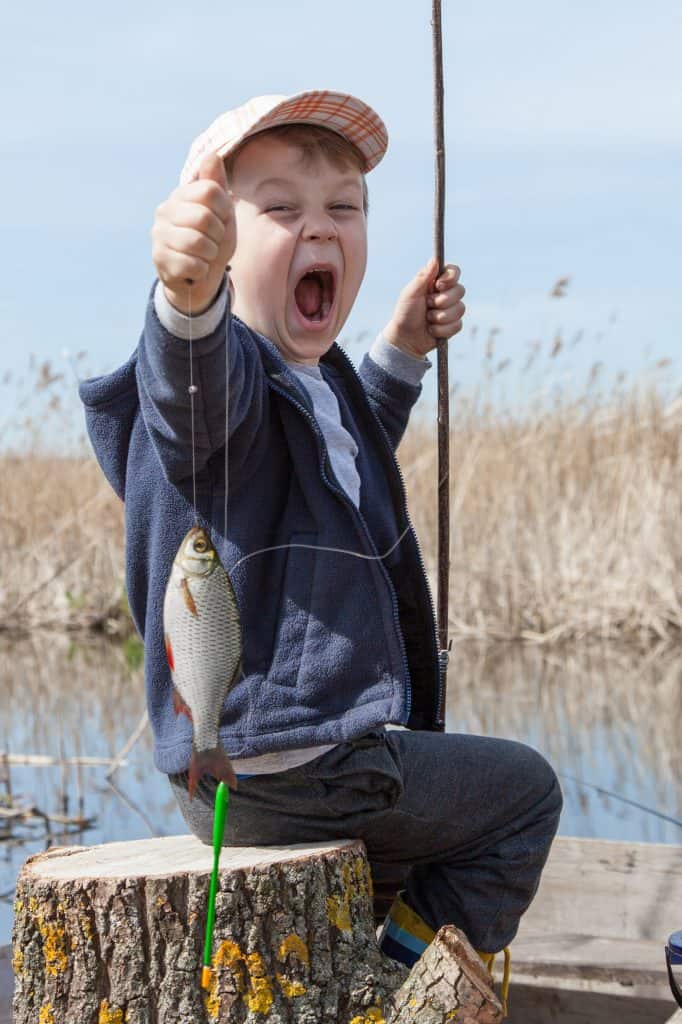
At the end of the day, you want your kids to look back on your fishing trip and remember it being fun. It’s important to educate everyone on how to be safe and bring along protective clothing, sunscreen, and fishing gear. But there are ways to make your family fishing trips more fun and more memorable.
Taking pictures as you go can be a good way to remember your experience. These can mark milestones in your children’s lives and give you memories to look back on.
Don’t be sad if you don’t catch very many fish during trips with your kids either. Make it feel like an exciting event any time one of them hooks a fish. Being enthusiastic about their accomplishments can really boost a child’s self-esteem and help them do better in the future.
Above all, you want your kids to have a good experience out in nature. As long as everyone is safe and has a good time, it doesn’t really matter what else happens.
Related Questions
What age can kids start fishing at? Children can begin learning to fish from the age of two. This is the age at which they begin to develop fine motor control. The best time for them to begin meaningfully learning and applying fishing techniques is age six.
Do kids need a fishing license? Fishing licenses for children have different rules for different states. Generally, children under the age of 12 are free to fish without a license. There may also be a reduced license fee for young teenagers. Catch and weight limits will still apply to all ages.

